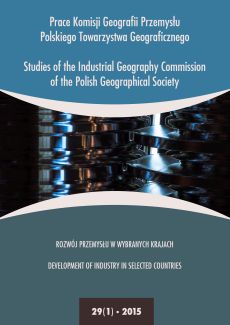Innovativeness of Polish industry against the global industry
DOI:
https://doi.org/10.24917/20801653.291.3Keywords:
barriers, innovation, industry, sourcesAbstract
The main purpose of this article is an attempt to assess the innovation of the Polish industry against the global industry. The analysis method was used in the research. The achievement of economic thought relating to innovation starting from Smith’s concept to Oslo methodology was presented in this article. The level of innovation of the Polish economy was determined with the use of statistical methods as well as indirect indicators based on the research and development intensity and direct indicators based on the results of product, process, organizational and marketing innovations. Subsequently, innovative activeness, innovative activity spending as well as revenue from sale of new products of small-, medium- and large-sized Polish enterprises were analyzed. The results were evaluated and compared with the world economy. Determinants of innovative activity of Polish industry entities indicating sources, main barriers and recommendations were determined in the conclusion on the basis of the conducted analyses and evaluations.
Downloads
Metrics
References
Chrzanowski, K. (2013, kwiecień). Polski przemysł high-tech – możliwości i bariery rozwoju. Sprawy Nauki, 179.
Działalność innowacyjna w Polsce (2014). Szczecin: GUS.
Gajda, W. (2014). The system of instruments stimulating the development strategies adopted by Central European enterprises. W: A. Marszk (red.). International context of business environment. Selected Evidence from CEE and SEE Countries. Gdańsk: Gdańsk University of Technology Publishing House, 128.
Global Innovation Index 2014. The Human Factor in Innovation (2014). Cornell University, INSEAD, WIPO. Fontainebleau, Ithaca, Geneva: WIPO and CII.
Gmurczyk, J. (2014, 3 listopada). Innowacyjność polskiej gospodarki. Stan obecny i rekomendacje. Pozyskano z http://www.instytutobywatelski.pl/wp-content/uploads/2014/04/.
Gregory, B.T., Rutherford, M.W., Oswald, S., Gardiner, L. (2005). An Empirical Investigation of the Growth Cycle of Small Firm Financing, Journal of Small Business Management, 43(4), 382–392.
Innovation Union Scoreboard 2014 (2014). European Union, Maastricht: Maastricht Economic and Social Research Institute on Innovation and Technology (UNU-MERIT).
Kalecki, M. (1986). Teoria dynamiki gospodarczej: rozprawa o cyklicznych i długofalowych zmianach gospodarki kapitalistycznej. Warszawa: PWN.
Kamieński, Z. (2011). Foresight technologiczny przemysłu – InSight2030. Streszczenie analizy końcowej. Warszawa: Wydawnictwo IZTECH.
Leśniak, G.J. (2013, 7 sierpnia). Ordynacja podatkowa w gruzach, trzeba nowej ustawy. Dziennik Gazeta Prawna.
Marshall, A. (1920). Industrial Organization, Continued. The Concentration of Specialized Industries in Particular Localities. W: Principles of Economics. London: Macmillan and Co.
Pigou, A.C. (1932). Inventions and Improvements. W: The Economics of Welfare. London: Macmillan and Co.
Podręcznik Oslo. Zasady gromadzenia i interpretacji danych dotyczących innowacji (2008). OECD, Eurostat. Warszawa: Ministerstwo Nauki i Szkolnictwa Wyższego, Departament Strategii i Rozwoju Nauki.
Say, J.B. (1855). Of the Labour of Mankind, of Nature, and of Machinery Respectively. W: C.C. Biddle (red.). A Treatise on Political Economy. Philadelphia: Lippincott, Grambo & Co.
Schumpeter, J. (1975). Capitalism, Socialism and Democracy. New York: Harper.
Smith, A. (1904). Of the Division of Labour. W: E. Cannan (red.). An Inquiry into the nature and Causes of the Wealth of Nations. London: Methuen & Co.
Strategia innowacyjności i efektywności gospodarki. Dynamiczna Polska 2020 (2013). Warszawa: Ministerstwo Gospodarki. Instytut Badań Rynku, Konsumpcji i Koniunktur.
Tarde, G. (1902). L’invention consideree comme, moteur de l’evolution socjale. Revue Internationale de Sociologie, 7, 561–574.
Downloads
Published
How to Cite
Issue
Section
License
Articles are published under the terms of the Creative Commons License (CC BY-ND 4.0; Attribution– NoDerivs).

